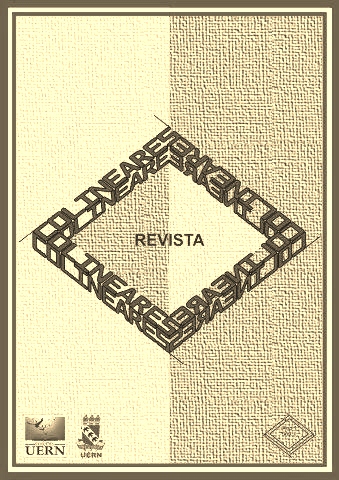2666 - "THE PART ABOUT THE CRIMES": CANON, THE CRIME NOVEL AS PART OF BUILDING AN IMAGINARY TERRITORY ON THE MEXICAN BORDER
Keywords:
Romance policial, Cânone, Roberto BolañoAbstract
This article begins with a question raised by Leela Gandhi (1998, p. 01-03): There is an academic production with little consensus and propositions? She answer saying that intellectuals are key players for the "libertarian counter-attack and they need to combine theory and practice and to set aside the dusty textbooks and assume that speak to a small number of partners.This reflection of Gandhi helps to bring out another issue: the narrative genres, understood as mass culture (crime novel, romance noir, thriller, etc.) can aspire a place on the academic studies? They are studied with such seriousness that may be part of what the intellectuals understand by canon?The ambiguities and ambivalences and the desire for social solidarity is one of the claims presented by Roberto Bolaño, through his narrator, in his book in 2666, but specifically in the chapter "The Past about the crimes" which I present as essay, knowing that it is still very to think and discuss.
Downloads
References
BARTHES, Roland. Ensayos críticos. Tradução. Carlos Pujol. Buenos Aires: Seix Barral, 2003.
BHABHA, Homi K. O Local da Cultura. Tradução Miriam Ávila, Eliana Lourenço de Lima Reis, Gláucia Renate Gonçalves. 2ªed. Belo Horizonte: Editora UFMG, 2013.
BOLAÑO, Roberto. Amuleto. Tradução Eraldo Brandão. São Paulo: Companhia das Letras, 2008.
_______. 2666. Trad. Eduardo Brandão. São Paulo: Companhia das Letras, 2010.
BRAITHWAITE, Andrés. Bolaño por sí mismo: entrevistas escogidas. Chile: Ediciones Universidad Diego Portales, 2006.
GARCÍA CANCLINI, Néstor. Imaginarios urbanos. Buenos Aires: Editorial Universitaria de Buenos Aires, 1999.
DEBORD, Guy. A sociedade do espetáculo. Tradução Estela dos Santos Abreu. Rio de Janeiro: Contraponto, 1997.
DE ROSSO, Ezequiel. Una lectura conjetural. Roberto Bolaño y El relato policial. In: MANZONI, Celina. Roberto Bolaño: la escritura como tauromaquia. Buenos Aires: Corregidor, 2006, p. 133-143.
DURING, Simon (Org). The Cultural Studies Reader. Oxford: Blackwell, 1994.
GANDHI, Leela. Postcolonial theory: a critical introduction. New York: Columbia University Press, 1998.
GIARDINELLI, Mempo. La novela negra en la América Hispana. In: Latin American Detective Fiction Writers: A Bio-bibliographical Sourcebook. Darrell B. Lockhart, editor. Disponível em: http://pt.scribd.com/doc/153934394/LaNovela-Negra-en-La-America-Hispana. Acesso em: 15.06.2014
HERRERA, José Galán. El canon de la novela negra y policíaca. In: Tejuelo, nº 1. 2008, p. 58-74. Disponível em: http://iesgtballester.juntaextremadura.net/web/profesores/tejuelo/vinculos/articulos/r0 1/05.pdf. Acesso em: 15.06.2014.
JARA, Carlos Burgos. Los crímenes de Santa Teresa: Estado, Globalización y mafia en 2666. In: RÍOS BAEZA, Felipe A. (org.). Roberto Bolaño: ruptura e violencia en la literatura finisecular. México: Colección Miradas del Centauro. Ediciones y Gráficos Eón, S.A. 2010, p.461- 473.
LINK, Daniel (org.) El juego de los cautos. Literatura policial: de Edgar A. Poe a P.D. James. Buenos Aires: La marca. 2003.
MARISTAIN, Mónica. El hijo de Míster Playa: una semblanza de Roberto Bolaño. México: Almadía. 2012.
MARTIN-BARBERO, Jesús. Dos meios í s mediações: comunicação, cultura e hegemonia. Tradução Ronald Polito e Sérgio Alcides. 5ed. Rio de Janeiro: Editora UFRJ. 2008.
MORIN. Edgar. Cultura de massas no século XX: o espírito do tempo. Tradução Maura Ribeiro Sardinha. 10ed. Rio de Janeiro: Forense Universitária. 2011.
MOURA, Jean-Marc. Exotisme et letters francophones. Paris: PUF, 2003.
NESTROVSKI, Arthur. SELIGMANN-SILVA, Marcio (Org). Catástrofe e representação: ensaios. São Paulo: Escuta, 2000.
PINO, Mirian. Bolaño y las relecturas de la novela negra: La pista de hielo. In. Literatura y Lingüística 17, p.117-128. Disponível em: http://www.redalyc.org/pdf/352/35201708.pdf. Acesso em:15.16.2013.
RÍOS BAEZA, Felipe A. (Org.). Roberto Bolaño una narrativa en el margen: desestabilizaciones en el canon y la cultura. Valencia: Tirant Humanidades. 2013.
SANTOS, Miriam López. Entre La novela negra y la estética gótica. Intersexiones, 2, 2011. P. 181-198. Disponível em: http://intersexiones.es/Numero2/10LopezSantos.pdf. Acesso em: 15.06.2013.
OLIVER. María Paz. Digresión subversión del género policial en Estrella distante de Roberto Bolaño. Acta Literaria. Concepción, n 44, I, 2012, p. 35-51. Disponível em: http://www.scielo.cl/scielo.php?pid=S0717-68482012000100003&script=sci_arttext. Acesso em 15.06.2013
TODOROV, Tzvetan. Tipologia del relato policial. In: LINK, Daniel (Org). Juegos de los Cautos. Literatura policial: de Edgar A. Poe a P.D. James. Buenos Aires: La marca. 2003.
VÁSQUEZ, Ainhoa. Ritual del bello crimen. Violencia femicida en Estrella distante. In: RÍOS BAEZA, Felipe A. Roberto Bolaño ruptura y violencia en la literatura finisecular. México: Ediciones Eón. 2010, p. 297-325.
YÚDICE, George. A conveniência da cultura: usos da cultura na era global. Tradução Marie-Anne Kremer. 2.ed. Belo Horizonte: Editora UFMG, 2013.
Downloads
Published
How to Cite
Issue
Section
License
Copyright (c) 2015 Sylvia Helena de Carvalho Arcuri, Victor Manuel Ramos Lemus

This work is licensed under a Creative Commons Attribution-NonCommercial-ShareAlike 4.0 International License.






